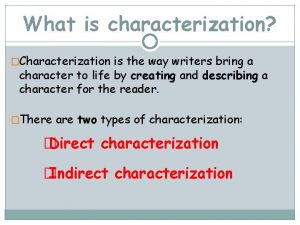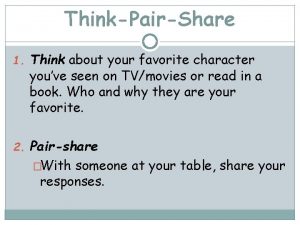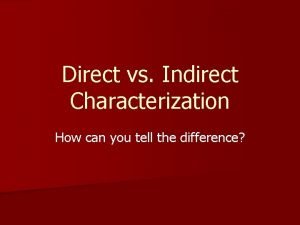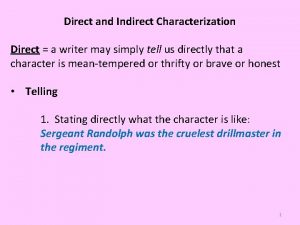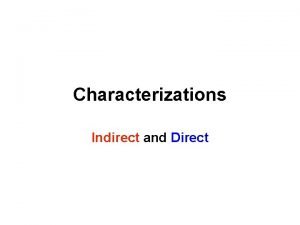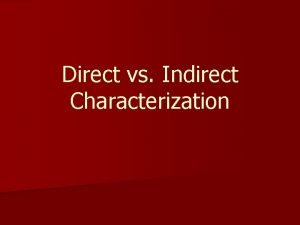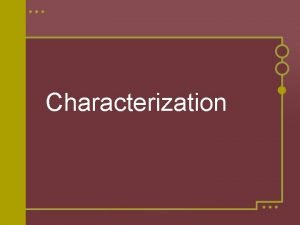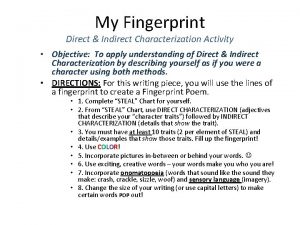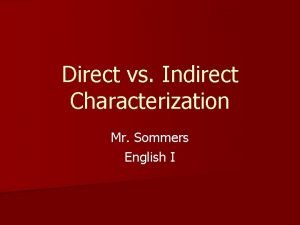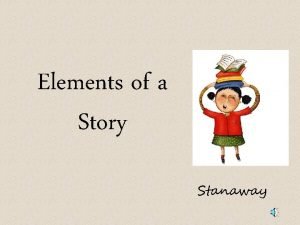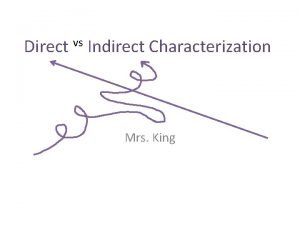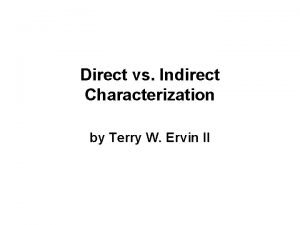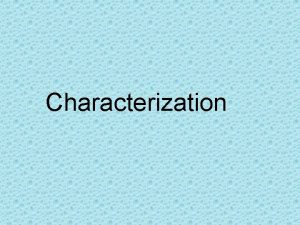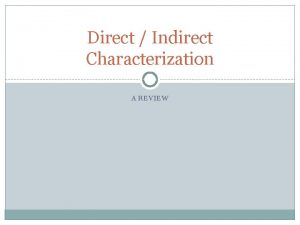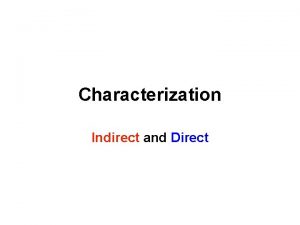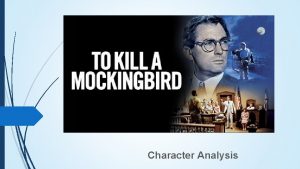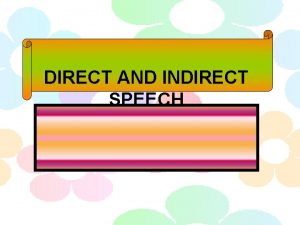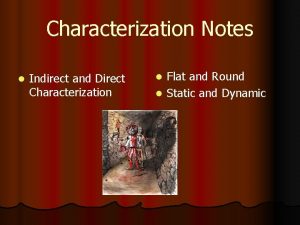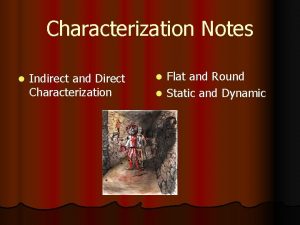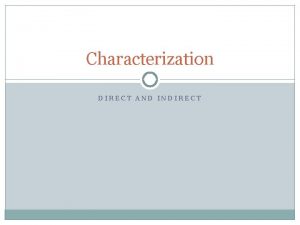Direct and Indirect Characterization Characterization is the way






















- Slides: 22

Direct and Indirect Characterization

Characterization is the way an author reveals the special qualities and personalities of a character in a story, making the character believable.

Analyzing Character Traits We try to figure out what a character in a book is like by paying attention to the clues the author gives us. This is called indirect characterization. The process of figuring out what the author is trying to say is called making inferences.

Example: Indirect Characterization What can you infer about the speaker in this passage? What type of person is she? “No, honey, I don’t want you to spend a lot of money on my birthday present. Just having you for a husband is the only gift I need. In fact, I’ll just drive my old rusty bucket of bolts down to the mall and buy myself a little present. And if the poor old car doesn't break down, I’ll be back soon. ”

Methods of Indirect Characterization • Speech • Thoughts • Emotions / Feelings • Actions • Looks (appearance)

Speech – We often get to know characters because of what they say to each other. Anita threw her arms around Tony and gave him a big hug. “Thank you so much for being there for me, ” she said. “I don’t think I could have faced my parents without you. ” thoughtful compassionate appreciative

Thoughts When an author lets us get inside the mind of a character, we can often learn a great deal about him or her. Butch looked around the neighborhood. “This would be a safe place to play catch with Bobby, ” he thought. “Why doesn’t Bobby throw the ball? ” He must be in a bad mood or something. ” loyal concerned playful

Emotions / Feelings When an author shares the character’s emotions, the readers can learn a lot about the character After working on the project for two years, Sarah couldn’t believe she wasn’t chosen for a promotion. Every time she saw Rachel, she wanted to cry. This is because Rachel got the promotion she wanted. angry jealous holds grudges

Actions – Much of what we learn about characters is revealed to us through what they do. Denise picked up the slimy bull frog. She could hardly stand to hold it even for a moment. She held it out at arm’s length from her body and quickly carried it to her brother. squeamish sensitive nervous

Looks (Appearance) The reader can infer a lot about characters from the clothes they wear, their facial features, their body language, and their mannerisms. Tex was the head rancher on the farm. When he rounds up the horses, he can be easily spotted with his beige hat and vest. Tex’s smile is a mile wide, even with his bushy mustache. jovial proud dedicated

Other character’s comments or reactions – sometimes other characters will tell us something useful about the character we’re reading about. “You wouldn’t believe what Lisa did yesterday, ” Sara said to her sister. “When we went into the bridal shop, she pushed all the women aside and demanded that the sales lady help us immediately. It was really something!” Demanding pushy assertive

Direct Characterization The writer tells you exactly (directly) what the character is like. Betsy was a determined three year old, who knew what she wanted and often got her way, if she cried loud enough. Mr. Mc. Carthy has an obnoxiously loud voice which he uses to intimidate his students. Did you eat your stupid chips for lunch today?

Quiz!!!!!!

1. Julie held up six different outfits in front of the mirror and pondered which would go best with her navy blue shoes, pastel eye shadow and the diamond earrings she’d already procured from her overflowing vanity. After ninety minutes of mixing and matching, and cellphoning her sister three times for advice, Julie finally made up her mind. A. Direct B. Indirect

2. Julie owned a multitude of outfits and accessories, and it always took her forever to decide which combination might impress Trent. As usual, she called her sister several times for advice. After doing so, Julie decided to give the navy blue skirt with the white sweater a try. A. Direct B. Indirect

3. Mr. Chong, whom I secretly nicknamed Old Chong, was very strange, always tapping his fingers to the silent music of an invisible orchestra. A. Direct B. Indirect

4. At once, Laura's throat clamped tight like a hinged lid. It was as if she had eyes in the back of her head, so she clearly could see Dianne and Steve grinning at her, waiting for her to make a fool of herself, again. A. Direct B. Indirect

5. "That was a pretty good poem that you wrote for English class. Your stuff is so good. I wish I could write like you, " Rachel said. A. Direct B. Indirect

6. _______ characterization is when the author does not come right out and explains the characters. Hints are dropped through their actions, interactions, and other aspects as well. 7. _______ characterization is when the author comes right out and explains the characters' traits without dropping hints. Ex: Rosaleen was a colored woman who did not know how to read.

8. "Listen to me, " he said, his fingers squeezing into my arms. "We were arguing like you said. We didn't see you at first. Then we turned around and you were standing there holding the gun. You'd picked it up off the floor. Then it just went off. " This indirect characterization of T. Ray describes his. . . A. Speech B. Thoughts C. Emotions/Personality D. Affect on others/Relationships E. Looks

9. Lily's choice to lie to the Calendar Sisters about her whole life story is an example of indirect characterization. Which example of "STEAL" is this? A. Speech B. Thoughts C. Emotions/Personality D. Affect on Others E. Looks

10. Relating to indirect characterization, what does STEAL stand for? A. Speech, Thoughts, Empathy, Attitude, Looks B. Speech, Thoughts, Emotions, Actions, Looks C. Specialty, Toughness, Emotions, Attitude, Looks D. Strongness, Tenderness, Empathy, Affect on others, Laughter
 Indirect characterization thoughts examples
Indirect characterization thoughts examples What does indirect characterization mean
What does indirect characterization mean Direct and indirect characterization examples
Direct and indirect characterization examples Indirect characterization thoughts examples
Indirect characterization thoughts examples Direct and indirect characterization
Direct and indirect characterization Direct characterizations
Direct characterizations Difference between direct and indirect characterization
Difference between direct and indirect characterization About my character
About my character Indirect characterization examples
Indirect characterization examples Teaching direct and indirect characterization
Teaching direct and indirect characterization Characterization is
Characterization is What is direct characterization
What is direct characterization Indirect vs. direct characterization
Indirect vs. direct characterization Speech characterization
Speech characterization Direct and indirect characterization activities
Direct and indirect characterization activities Betty parris the crucible indirect characterization
Betty parris the crucible indirect characterization Direct and indirect characterization
Direct and indirect characterization Direct and indirect characterization quiz
Direct and indirect characterization quiz Direct and indirect characterization
Direct and indirect characterization Indirect v direct characterization
Indirect v direct characterization Define indirect characterization
Define indirect characterization Indirect characterization paragraph example
Indirect characterization paragraph example A good author reveals a character through
A good author reveals a character through


